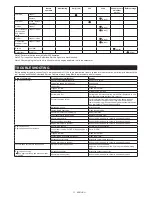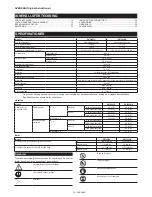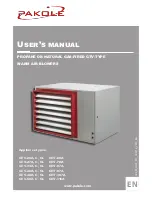
Intended use
The tool is intended for blowing dust.
Starting up the blower
1.
Make sure that there are no children or other people within
a working range of 15 meters, also pay attention to any ani-
mals near by.
2.
Before operating, always check that the blower is safe for
operation:
—
Check the security of the throttle lever. The throttle
lever should be checked for smooth and easy action.
—
Check for proper functioning of the throttle lever lock.
—
Check for clean and dry handles and test the function of
the l-O switch. Keep handles free of oil and fuel.
3.
Start the Blower only in accordance with the instructions.
Do not use any other methods for starting the engine.
4.
Use the blower and the tools supplied only for applications
specified.
5.
Start the blower engine only after the entire tool has been
assembled. Operation of the tool is permitted only after all
the appropriate accessories are attached.
6.
The engine is to be switched off immediately if there are any
engine problems.
7.
When working with the blower, always wrap your fingers
tightly around the handle, keeping the control handle cra-
dled between your thumb and forefinger. Keep your hand
in this position to have your machine under control at all
times. Make sure your control handle is in good condition
and free of moisture, pitch, oil or grease.
8.
Always ensure a safe, well-balanced footing.
9.
Carry the blower properly on both shoulders during opera-
tion. Do not carry the blower with only one shoulder strap.
Otherwise personal injury may result.
10.
Operate the blower in such a manner as to avoid inhalation
of the exhaust gases. Never run the engine in enclosed
rooms (risk of suffocation and gas poisoning). Carbon mon-
oxide is an odorless gas. Always ensure there is adequate
ventilation.
11.
Switch off the engine when resting or leaving the blower
unattended. Place it in a safe location prevent danger to
others, setting fire to combustible materials, or damage to
the machine.
12.
Never lay the hot blower onto dry grass or onto any com-
bustible materials.
13.
All protective parts and guards supplied with the machine
must be used during operation.
14.
Never operate the engine with a faulty exhaust muffler.
Transport
1.
Shut off the engine during transport.
2.
Position the blower safely during car or truck transportation
to avoid fuel leakage.
3.
When transporting the blower, ensure that the fuel tank is
completely empty.
4.
Lift the blower with holding carry handle when you carry it.
Do not drag the blower by nozzle, pipe or other parts.
5.
Hold the blower firmly during transportation.
6.
When transport the blower, bend your knee and make sure
you do not damage your shoulder and lower back.
Refuelling
1.
Shut off the engine during refuelling, keep well away from
open flame and do not smoke.
2.
Avoid skin contact with petroleum products. Do not inhale
fuel vapor. Always wear protective gloves during refuelling.
Change and clean protective clothing at regular intervals.
3.
Take care not to spill either fuel or oil in order to prevent soil
contamination (environmental protection). Clean the blower
immediately after fuel has been spilt. Allow wet cloths to dry
before disposing in properly, covered container to prevent
spontaneous combustion.
4.
Avoid any fuel contact with your clothing. Change your
clothing immediately if fuel has been spilled on it (fire
hazard).
5.
Inspect the fuel cap at regular intervals making sure that it
stays securely fastened.
6.
Carefully tighten the locking screw of the fuel tank. Change
locations to start the engine (at least 3 meters (10 ft) away
from the place of refuelling).
4 ENGLISH
Summary of Contents for EB7660WH
Page 131: ...131 ...





































